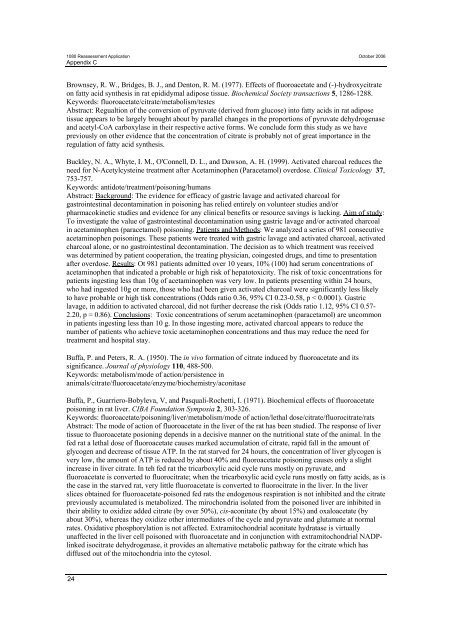Source: Landcare Research (1964). Control of poisons. Royal ...
Source: Landcare Research (1964). Control of poisons. Royal ...
Source: Landcare Research (1964). Control of poisons. Royal ...
Create successful ePaper yourself
Turn your PDF publications into a flip-book with our unique Google optimized e-Paper software.
1080 Reassessment Application October 2006<br />
Appendix C<br />
Brownsey, R. W., Bridges, B. J., and Denton, R. M. (1977). Effects <strong>of</strong> fluoroacetate and (-)-hydroxycitrate<br />
on fatty acid synthesis in rat epididymal adipose tissue. Biochemical Society transactions 5, 1286-1288.<br />
Keywords: fluoroacetate/citrate/metabolism/testes<br />
Abstract: Regualtion <strong>of</strong> the conversion <strong>of</strong> pyruvate (derived from glucose) into fatty acids in rat adipose<br />
tissue appears to be largely brought about by parallel changes in the proportions <strong>of</strong> pyruvate dehydrogenase<br />
and acetyl-CoA carboxylase in their respective active forms. We conclude form this study as we have<br />
previously on other evidence that the concentration <strong>of</strong> citrate is probably not <strong>of</strong> great importance in the<br />
regulation <strong>of</strong> fatty acid synthesis.<br />
Buckley, N. A., Whyte, I. M., O'Connell, D. L., and Dawson, A. H. (1999). Activated charcoal reduces the<br />
need for N-Acetylcysteine treatment after Acetaminophen (Paracetamol) overdose. Clinical Toxicology 37,<br />
753-757.<br />
Keywords: antidote/treatment/poisoning/humans<br />
Abstract: Background: The evidence for efficacy <strong>of</strong> gastric lavage and activated charcoal for<br />
gastrointestinal decontamination in poisoning has relied entirely on volunteer studies and/or<br />
pharmacokinetic studies and evidence for any clinical benefits or resource savings is lacking. Aim <strong>of</strong> study:<br />
To investigate the value <strong>of</strong> gastrointestinal decontamination using gastric lavage and/or activated charcoal<br />
in acetaminophen (paracetamol) poisoning. Patients and Methods: We analyzed a series <strong>of</strong> 981 consecutive<br />
acetaminophen poisonings. These patients were treated with gastric lavage and activated charcoal, activated<br />
charcoal alone, or no gastrointestinal decontamination. The decision as to which treatment was received<br />
was determined by patient cooperation, the treating physician, coingested drugs, and time to presentation<br />
after overdose. Results: Ot 981 patients admitted over 10 years, 10% (100) had serum concentrations <strong>of</strong><br />
acetaminophen that indicated a probable or high risk <strong>of</strong> hepatotoxicity. The risk <strong>of</strong> toxic concentrations for<br />
patients ingesting less than 10g <strong>of</strong> acetaminophen was very low. In patients presenting within 24 hours,<br />
who had ingested 10g or more, those who had been given activated charcoal were significantly less likely<br />
to have probable or high tisk concentrations (Odds ratio 0.36, 95% CI 0.23-0.58, p < 0.0001). Gastric<br />
lavage, in addition to activated charcoal, did not further decrease the risk (Odds ratio 1.12, 95% CI 0.57-<br />
2.20, p = 0.86). Conclusions: Toxic concentrations <strong>of</strong> serum acetaminophen (paracetamol) are uncommon<br />
in patients ingesting less than 10 g. In those ingesting more, activated charcoal appears to reduce the<br />
number <strong>of</strong> patients who achieve toxic acetaminophen concentrations and thus may reduce the need for<br />
treatmernt and hospital stay.<br />
Buffa, P. and Peters, R. A. (1950). The in vivo formation <strong>of</strong> citrate induced by fluoroacetate and its<br />
significance. Journal <strong>of</strong> physiology 110, 488-500.<br />
Keywords: metabolism/mode <strong>of</strong> action/persistence in<br />
animals/citrate/fluoroacetate/enzyme/biochemistry/aconitase<br />
Buffa, P., Guarriero-Bobyleva, V, and Pasquali-Rochetti, I. (1971). Biochemical effects <strong>of</strong> fluoroacetate<br />
poisoning in rat liver. CIBA Foundation Symposia 2, 303-326.<br />
Keywords: fluoroacetate/poisoning/liver/metabolism/mode <strong>of</strong> action/lethal dose/citrate/fluorocitrate/rats<br />
Abstract: The mode <strong>of</strong> action <strong>of</strong> fluoroacetate in the liver <strong>of</strong> the rat has been studied. The response <strong>of</strong> liver<br />
tissue to fluoroacetate posioning depends in a decisive manner on the nutritional state <strong>of</strong> the animal. In the<br />
fed rat a lethal dose <strong>of</strong> fluoroacetate causes marked accumulation <strong>of</strong> citrate, rapid fall in the amount <strong>of</strong><br />
glycogen and decrease <strong>of</strong> tissue ATP. In the rat starved for 24 hours, the concentration <strong>of</strong> liver glycogen is<br />
very low, the amount <strong>of</strong> ATP is reduced by about 40% and fluoroacetate poisoning causes only a slight<br />
increase in liver citrate. In teh fed rat the tricarboxylic acid cycle runs mostly on pyruvate, and<br />
fluoroacetate is converted to fluorocitrate; when the tricarboxylic acid cycle runs mostly on fatty acids, as is<br />
the case in the starved rat, very little fluoroacetate is converted to fluorocitrate in the liver. In the liver<br />
slices obtained for fluoroacetate-poisoned fed rats the endogenous respiration is not inhibited and the citrate<br />
previously accumulated is metabolized. The mirochondria isolated from the poisoned liver are inhibited in<br />
their ability to oxidize added citrate (by over 50%), cis-aconitate (by about 15%) and oxaloacetate (by<br />
about 30%), whereas they oxidize other intermediates <strong>of</strong> the cycle and pyruvate and glutamate at normal<br />
rates. Oxidative phosphorylation is not affected. Extramitochondrial aconitate hydratase is virtually<br />
unaffected in the liver cell poisoned with fluoroacetate and in conjunction with extramitochondrial NADPlinked<br />
isocitrate dehydrogenase, it provides an alternative metabolic pathway for the citrate which has<br />
diffused out <strong>of</strong> the mitochondria into the cytosol.<br />
24








![Application for test certificate [pdf, 131kb]](https://img.yumpu.com/50666502/1/184x260/application-for-test-certificate-pdf-131kb.jpg?quality=85)








